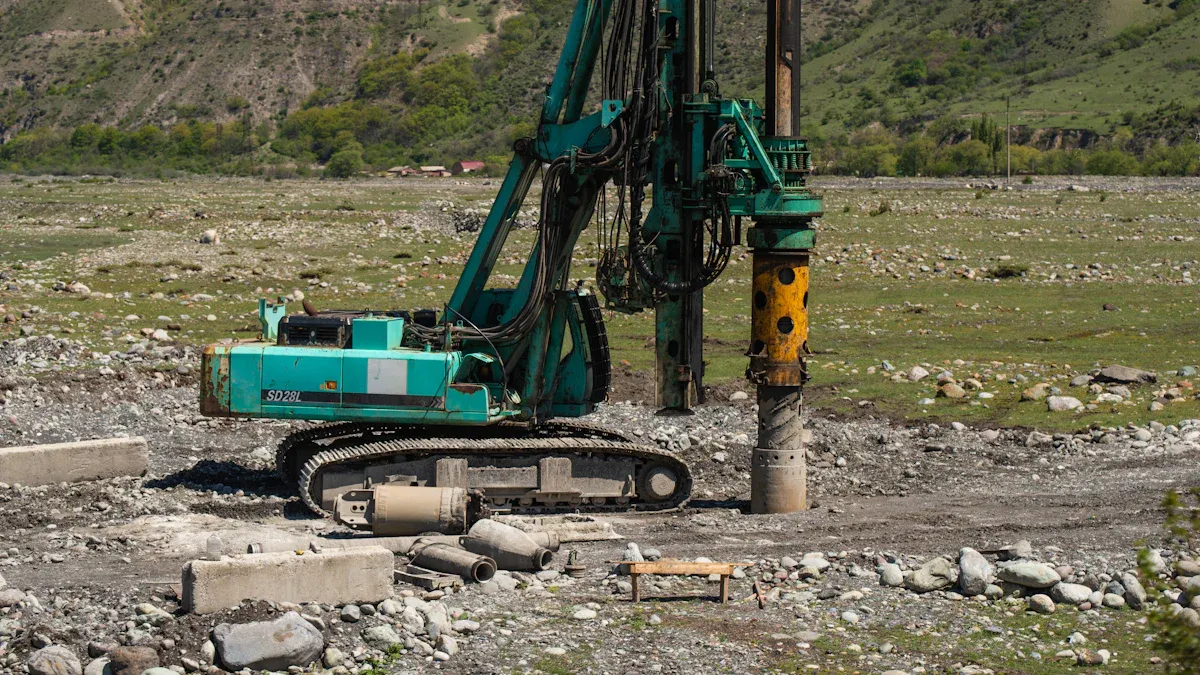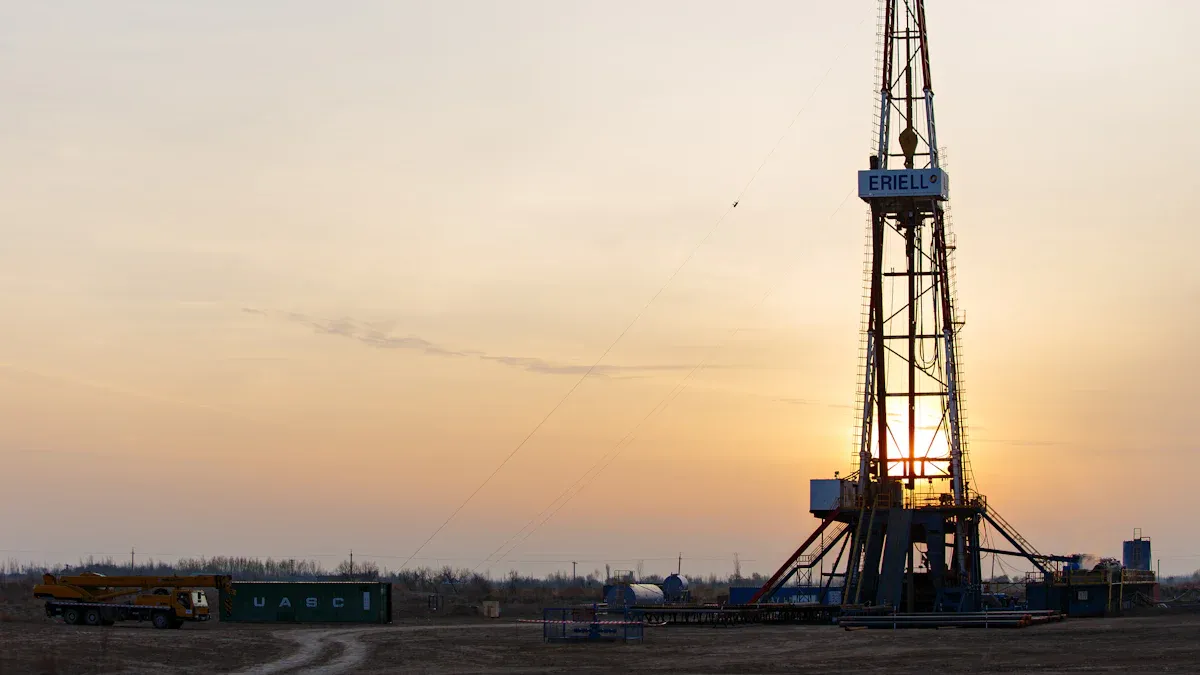
Drilling jobs need the right tools to work well. A Kellybar is important for moving torque during drilling. Friction Kelly bars work using friction between their parts. They are good for jobs with lighter loads. Interlocking Kelly bars use locks to move torque. They are strong and great for heavy work. Knowing these differences helps you pick the best tool for your job.
Key Takeaways
- Friction Kelly bars work well for shallow drilling in soft dirt. They are easy to use and cheap, great for small jobs.
- Interlocking Kelly bars have locks to transfer power. They are strong and dependable, good for deep drilling in hard ground.
- Taking care of both types is very important. Tighten friction parts and check interlocking bar locks to keep them working well.
- Pick friction Kelly bars for low-cost projects. Use interlocking bars when you need strength and toughness for heavy work.
- Knowing these differences helps you pick the right tool. This makes sure your drilling job is done successfully.
Mechanism of Torque Transmission in Kellybars

Friction Kelly Bars: How They Work
Friction Kelly bars use a simple way to move torque. They have sections that slide into each other like tubes. When the rig turns, friction between the sections moves the force to the tool. This works best when the parts fit tightly and line up well.
These bars are good for shallow drilling jobs. They work well with lighter loads because they rely on friction. But if the load gets heavy or the soil is tough, friction might not hold enough. This makes them less useful for hard drilling tasks.
One benefit of the Kelly bars is their easy design. They are simpler to fix and take care of than complex tools. If you need a cheaper option for basic drilling, this type might be a good pick.
Interlocking Kelly Bars: How They Work
Interlocking Kelly bars use locks to move torque. These locks connect the sections when they stretch out. When the rig turns, the locks keep the sections firmly together. This lets the bar handle heavy loads and work better.
These bars are great for deep drilling or tough soil. They work well in rocky or hard ground because the locks stop slipping. Even under stress, they stay strong and reliable.
Interlocking Kelly bars last longer but need more care. The locks must be checked often to make sure they work right. If your project needs strength and dependability, this type is a smarter choice.
Applications of Kellybars in Drilling

Friction Kelly Bars: Best Use Cases
Friction Kelly bars are great for shallow drilling tasks. They work well in soft or medium soil. Use them for small foundations, retaining walls, or shallow piles. These bars are best when the soil is not too hard.
If your project has a tight budget, they are a good choice. Their simple design makes repairs and maintenance easier. This saves time and money. But avoid using them in rocky or very hard soil. The friction system may not hold torque in tough conditions.
Tip: Check the sections fit tightly before starting. This helps the friction system work properly.
Interlocking Kelly Bars: Best Use Cases
Interlocking Kelly bars are perfect for tough drilling jobs. Use them for deep foundations like bridges or tall buildings. They handle heavy loads and work well in hard soil, gravel, or rock.
The locking system keeps them stable and prevents slipping. They are reliable for high-pressure projects. If your job involves different soil layers, these bars are strong and durable. They are also better for long, precise drilling tasks.
Note: Inspect the locks often to keep them working well. This avoids delays during important drilling work.
Performance and Durability of Kellybars
Friction Kelly Bars: Strengths and Limitations
Friction Kelly bars are simple and affordable. Their design makes fixing and upkeep easy. This helps save time during projects. They work well for light drilling in soft soil. These bars are a good choice for smaller, low-cost jobs.
But they don’t last as long under tough conditions. Heavy loads or rough soil can wear them out quickly. Over time, the sliding parts may not fit tightly anymore. This makes them less effective. For hard soil or long-term use, they might not be the best option.
Tip: Check the sliding parts often to keep them tight. This can help your friction kelly bar last longer.
Interlocking Kelly Bars: Strengths and Limitations
Interlocking Kelly bars are strong and long-lasting. Their locks keep them steady under heavy force. They are made from tough materials like strong steel and special alloys. These materials help them handle hard jobs better. For example:
| Material Type | What It Does | Why It’s Useful |
|---|---|---|
| High-strength steel | Very strong and hard to bend | Works well in tough drilling conditions |
| Wear-resistant materials | Stays strong against rubbing and scraping | Lasts longer with fewer repairs |
| Alloy compositions | Resists damage and lasts a long time | Reliable for big projects |
These materials stop bending, breaking, or wearing out too fast. Special surface treatments make them even tougher. This means they last longer and need fewer fixes.
However, interlocking Kelly bars need regular care. The locks must be checked often to avoid problems. They also cost more at first because of their advanced design. But their long life and strength make up for the higher price.
- Key benefits include:
- Strong performance in tough conditions due to strong steel.
- Less downtime and fewer repairs with wear-resistant materials.
- Longer life thanks to special surface treatments.
For deep drilling or hard soil, interlocking kelly bars are a smart choice.
Knowing how friction and interlocking Kelly bars differ helps you pick the right tool. Friction Kelly bars use sliding parts to move force. They work best for shallow drilling in soft ground. Interlocking Kelly bars have locks that make them stronger. They are better for deep drilling in hard soil.
Friction Kelly bars are cheaper and good for light jobs. They are a smart choice if your budget is small. Interlocking kelly bars are strong and last longer. They work well for heavy loads in tough soil. Pick the right type based on your project’s depth and soil. This helps your drilling job succeed.
FAQ
What is the main difference between friction and interlocking Kelly bars?
Friction Kelly bars use sliding parts to move torque. Interlocking Kelly bars use locks to keep sections together. Friction bars are better for light jobs, while interlocking bars handle heavy work.
Which Kelly bar should you choose for shallow drilling?
Pick a friction Kelly bar for shallow drilling tasks. It works well in soft or medium soil and costs less. Avoid using it in rocky or very hard ground.
How do you maintain interlocking Kelly bars?
Check the locks often to make sure they work well. Clean them to remove dirt or debris. Add oil to moving parts to stop wear. These steps help the bar last longer and work better.
Are friction Kelly bars more affordable than interlocking ones?
Yes, friction Kelly bars cost less than interlocking ones. Their simple design makes them cheaper to make. They also need less care, which saves money for light drilling jobs.
Can interlocking Kelly bars handle rocky soil?
Yes, interlocking Kelly bars work well in rocky soil. Their locks stop slipping and keep them steady. This makes them great for tough jobs like drilling in gravel or rock.
Tip: Always choose the right Kelly bar for your soil and depth needs to get the best results.


